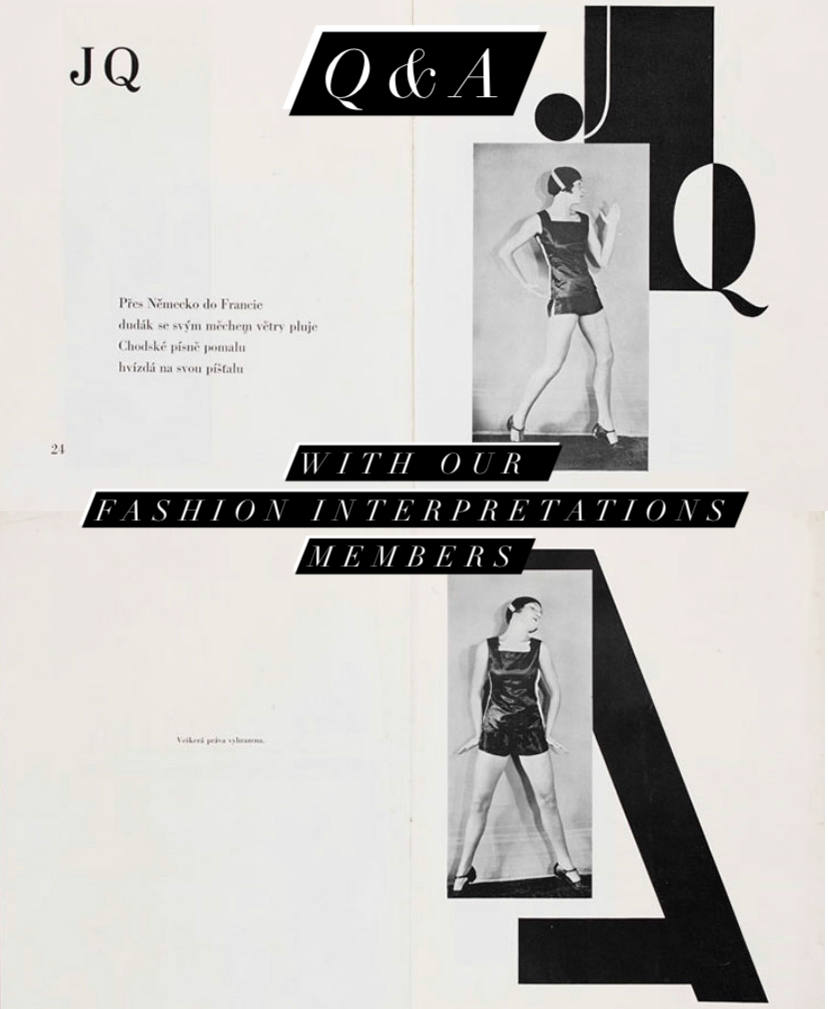
In the next few weeks leading up to our symposium, we will be asking our members a few questions regarding their work for the project, how their take on medium has potentially shifted over the course of the past year and the connections they have made with the work / research being conducted by other Fashion Interpretations members…
Rebecca Arnold
Principal Investigator
What is your favourite fashion medium?
Photography. I love most forms of fashion representation, but photographs are the medium that I am most drawn to – it’s where most of my writing projects begin.
What have you learnt from focusing on medium?
That it’s important to think about how dress is mediated, to consider the ways it is represented and the web of contexts and intent that bring an image into being. Also, how fascinating it is to analyse the ways we interact with a particular medium, and how this impacts our relationship to fashion.
What is your favourite example from your research that shows medium impacting fashion’s meanings?
I really love the Man Ray solarisation I studied that shows Mme Gres gown as though in a black and white negative with flashes of applied colour. The way he presents the model and the dress really makes you stop and consider what you can – and can’t – see. He makes you aware of his intervention between the scene he shot in the studio, how he treated the print, and then how it appears on the magazine page. The image is about so much more than a dress …
Can you think of any links that have presented themselves between yours and another project members’ work during this process?
One of my favourite aspects of being a part of this group has been seeing how our separate projects would interconnect – sometimes in deeper ways, for example, Richard Haines’ beautiful exploration of 1930s couture links to what I was thinking about and it was such a pleasure to see how this played out in his drawings.
Dal Chodha
Founder of Archivist Addendum
What is your favourite fashion medium?
Of course, it’s print, but print that offers something more than just weight in my hands or takes up space on a shelf. There has been a mass abuse of the print medium in the last decade – by this I mean that too much stuff is being produced with little care. A lot of the magazines and books made today would suffice as being purely digital material. Paper is a resource that we are running out of. It should be treated with respect.
What one image / story / example best articulates your tie to your chosen fashion medium?
There are so many examples of wonderful printing and tactile experiences but something that has stayed with me for well over a decade is the large-format art magazine Kilimanjaro by Olu Odukoya. Today Olu publishes Modern Matter but the spirit and tactility of Kilimanjaro still affects me to this day. It’s a sensorial experience, it’s a ‘magazine’ you make space for, it commands a certain level of engagement. I also love Loewe’s Past, Present, Future (2016) and Gina Bucher’s Female Chic. Thema Selection (2015). These are two books that make me angry because I wasn’t involved in making them! They are breath-taking. They make you realise what a considered meeting of paper, ink and glue, photos and text can do.
What have you learnt from focusing on medium?
My tool is language, words, but I always think of the words in a visual way. For me it’s important to know how my words will sit on the page or screen. It helps me to write with clarity and rigour. I enjoy the physicality of print media but I am not romantic about it – a lot of things do not need to clear out huge swathes of forests or pump ink and chemicals into the sea. With Archivist Addendum, Jane and I are driven by a curatorial, punkish approach to publishing. It is hand made. It is quite literally self-published. It gives us an immense amount of stress and freedom.
What is your favourite example from your research that shows medium impacting fashion’s meanings?
The arrival of the ‘phygital’ show has been interesting. Of course, you had some notable highs like Jonathan Anderson and M/M (Paris)’s ‘show in a box’ for Loewe or Bottega Veneta sending out mini projectors loaded with their latest short film. This playfulness and interaction feels new. When seated at a show, we see clothes from a fixed position – it is a position that is both physical and metaphorical. When the work is being disseminated in your own front room, you look at it differently. It affects you differently. I do worry that it becomes almost too playful, like a game, or a distraction from the clothes, but with the world the way that it is at the moment, perhaps that’s what we need.
Can you think of any links that have presented themselves between yours and another project members’ work during this process?
With Rebecca’s research on Man Ray (and in particular his use of solarisation) there’s a link in the ambiguity of the fashion image – how what we are shown is sometimes not what we can see. Judith and Roman’s work brings up the issues of curation and grouping together of images, which as an editor, is part of my job. Leanne’s paintings elevate lo-fi eBay photographs into something more special, something more urgent. Our shoot of the A.F.Vandevorst archives with Sofie & Maarten was done a day before Belgium went into lockdown. Jane and I were forced to stop for a few days in a new city. It gave us the space to feel okay about the fluidity of what we are trying to do with Archivist Addendum.
Fran Crossley
AHRC Networking Project Administrator
What is your favourite fashion medium?
Oh, this is difficult. It’s hard to choose between photography / film/theatre / literature. I recently reread Daphne du Maurier’s Rebecca (1938) and forgot how transformative the description of dress can be within a novel, how much it can convey about a person’s “station” (such an old-timey concept), their personhood. I revelled in retracing the ball scene in particular, Mrs de Winter’s abject terror and shame (you can quite literally feel it quivering through the pages). I was instantly transported to Hitchcock’s 1940 adaptation; Joan Fontaine in her own interpretation of Caroline de Winter’s flouncy, ultra-feminine white gown – oh, the horror.

What one image / story / example best articulates your tie to your chosen fashion medium?
If I’m sticking with literature here, I have always been a little bit obsessed with Virginia Woolf’s “clothes complex.” That fine line that you feel her walking, between desire and revulsion, how she was simultaneously concerned with and preoccupied by her relationship with dress, her view of fashion as a “trivial concern”. Social artifice, a notion so often associated with fashion, is so readily misconstrued as being woven into the discipline’s fabric. I was always so fascinated with how she grappled with fashion’s contradictions. Fascinated with how dress, even its language, is endlessly revisited in her writing: ‘There stood the great house with all its windows robed in silver.’ [Virginia Woolf, Orlando (1928), (London: Penguin Books Ltd., 2006), p.291]
There’s a passage in Orlando that has always stayed with me, I think of it often when I’m examining fashion imagery, considering how dress can be understood as a form of body modification, it’s very special and very Woolf:
‘There is much to support the view that it is clothes that wear us and not we them. We may make them take the mould of arm or breast, but they mould our hearts, our brains, our tongues to their liking.’ [Virginia Woolf, Orlando (1928), (London: Penguin Books Ltd., 2006), p.167]
I have always warmed to the idea of dress moulding my heart / brain / tongue. Fashion is at the forefront of my mind near-constantly throughout the day, be it in my own dress or in my work, and again, I discuss and consider it a great deal. It will remain a treasure, to be shared and cherished. I like the idea of our physical forms being fundamentally reordered through fashion.
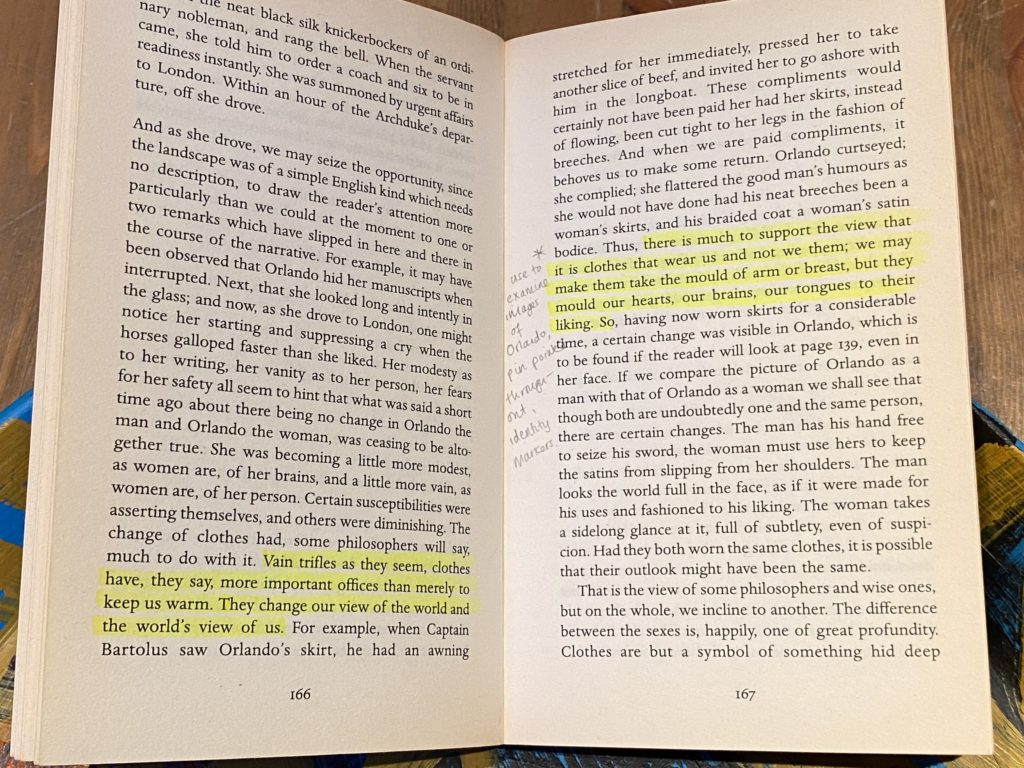
What have you learnt from focusing on medium?
That medium permeates through everything, through all manner of stimulus, not just in fashion. It has made me consider how I digest information in everyday life, not just when I am examining fashion imagery. Also, using the term “medium” as an umbrella definition, it gives me greater focus when categorising what I am encountering – for example, just this afternoon (Tuesday, 10 November 2020), SHOWstudio posted a video on their Instagram account urging their followers to ‘escape into the world of fashion film with a playlist curated by the SHOWstudio staff’, https://www.instagram.com/p/CHaatIZnvMO/. In this selection of clips, we see fashion photography, videography, aligned with specific pieces of music, each exploring a fashion-centric theme – ‘society’s obsession with images of celebrities and our voyeuristic tendencies when it comes to icons, to ‘Beasting’ … (to) the ascent of women’s workwear … a multilateral dance between man and mother nature.’ Fashion can house all these varied, multi-faceted narratives, and retell them to us through the most innovative, exciting mediums.
What is your favourite example from your research that shows medium impacting fashion’s meanings?
As Fashion Interpretations’ Networking Project Administrator, I haven’t exactly partaken in researching for this project. However, I have been responsible for our Instagram account over the course of the past year, and in seeking out new content every week, I have found hundreds of examples that successfully demonstrate how medium meaningfully impacts upon fashion’s meanings. A favourite? Discovering the MAZAHUACHOLOSKATOPUNK kids of Mexico City, via the work of photographer Federico Gama.
“What I was seeing right outside my window was something truly extraordinary, and it suggested a substantive continuation of themes I’d been exploring in the previous fifteen years: cultural migrations, identity, and dress as a form of expression … They employ these Sunday disguises, outfits or even vestments to adopt other personalities in a representative sense …” – Federico Gama [https://www.instagram.com/p/B4iE-R9BftE/]
Less fashion photography, more documentary photography; Gama highlights stories in which fashion acts as the communicative tool. In this series, “MAZAHUACHOLOSKATOPUNK” or “Hidden” Gama explores the nuances present in society’s pre-organised fashion factions, where we place ourselves, how we rebel, how we seek to redefine fashion stereotypes. In this example, his photography allows me to reconsider how self-expression through fashion can be depicted.

Leanne Shapton
Project member / Author, artist and publisher
What is your favourite fashion medium?
Amateur photography for the selling of secondhand clothes. Because these images carry traces of the owners relationship to items, clothing or fashion, and also because the medium is not necessarily seen as an art form, or as a form at all, it’s more in line with a classified ad. But the more this kind of market evolves, the photography evolves, too, and the messages sent through established and changing codes and conventions is modern, to me.
What one image / story / example best articulates your tie to your chosen fashion medium?
I love this image of socks:
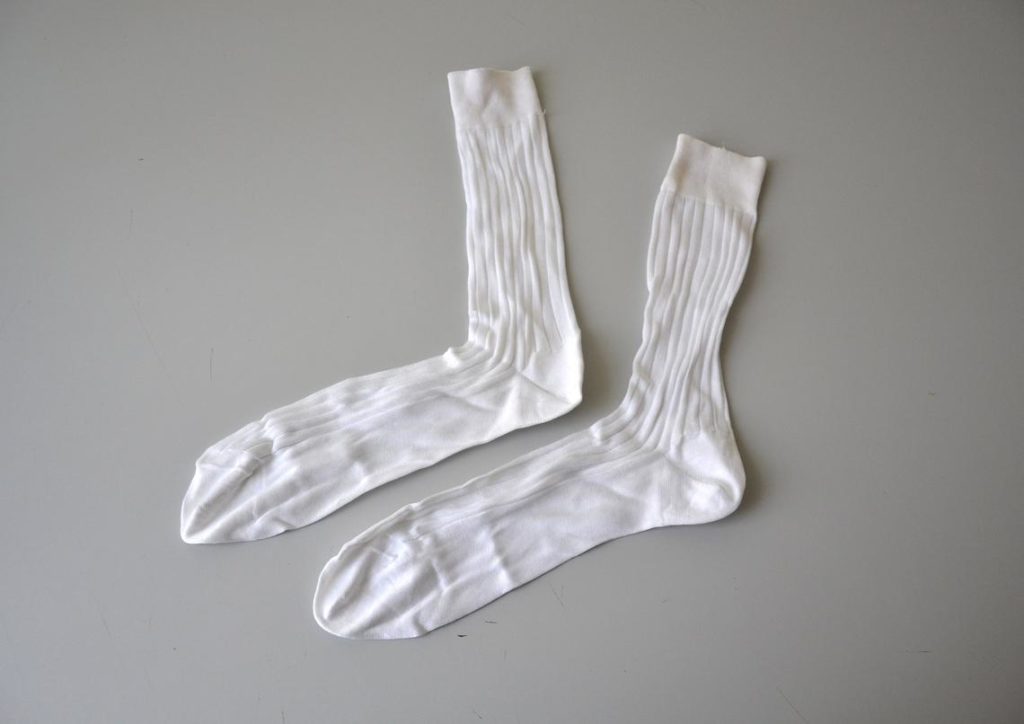
What have you learnt from focusing on medium?
I’ve learned, like with any focus, comes a kind of literacy, a fluency with reading between the “lines” of an image or medium.
What is your favourite example from your research that shows medium impacting fashion’s meanings?
I don’t have a favorite example, but I think the disembodied article of clothing, photographed flattened on a floor, is encouraging— in general— a more scientific or forensic study of the value of clothes and fashion and design. When items are not mediated by a model, stylist, photographer, advertiser and editor, the consumer might develop a different relationship to assessing clothes. Less illusory, more academic.
Can you think of any links that have presented themselves between yours and another project members’ work during this process?
Perhaps with Lisa Cohen’s work— the idea of the histories and previous lives of clothes.
Elisa de Wyngaert
Project member / Fashion Curator, MoMu Fashion Museum in Antwerp
What is your favourite fashion medium?
Creating fashion exhibitions and the accompanying publications are my fashion media of choice. However, in these, we include many different fashion medias, from photography, garments, to films and oral history. This seemingly simple question is a rather tricky one for me, it’s like choosing between my favourite desserts or songs: it could alter from day to day. I do find myself deeply moved by seeing an old lady in a raspberry pink jacket and statement necklace, and I am touched every time I see a lost garment on the street, such as a silk scarf waving in the wind or just one silly shoe… I am attracted to the tactility of fashion and fascinated by the way garments play a role in people’s lives and the way traces of memory are found in garments. My love for personal stories, emotions and experiences connected to fashion is the reason I wanted to work as a fashion curator.
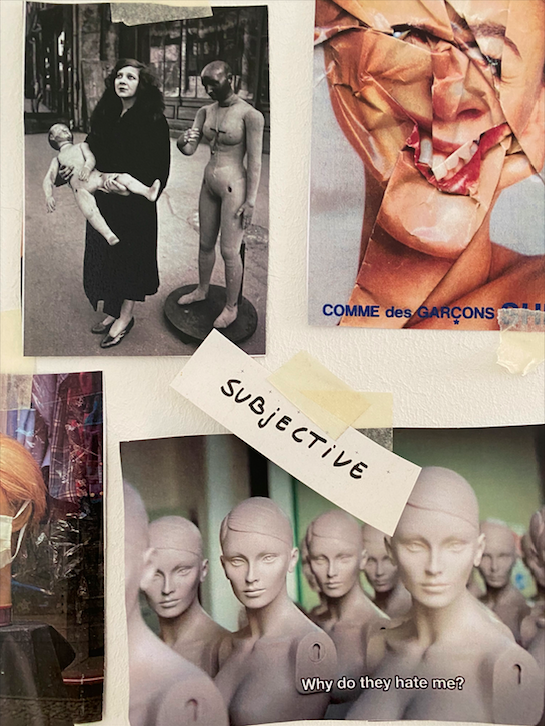
What have you learnt from focusing on medium?
In the past few months, most of us were house bound. For safety reasons, exhibitions were closed, and are currently again closed. For this project, I’ve built a 2D ‘take me home exhibition’ on my living room wall. It’s an exhibition of dreams that will never happen in this constellation, but will no doubt inspire my future curations. Since lockdown, I became even more intrigued by the transformation exhibitions undergo from being a 2D collage to becoming a real, built environment. The mannequin plays a big role in this transition and I have been thinking a lot about the importance of working with the right mannequins. I’ve spent many hours walking around Antwerp, Berlin and Brussels, discovering and photographing display mannequins behind windows. We should never underestimate the part these sculptures of people play the emotional experience of a fashion exhibition.
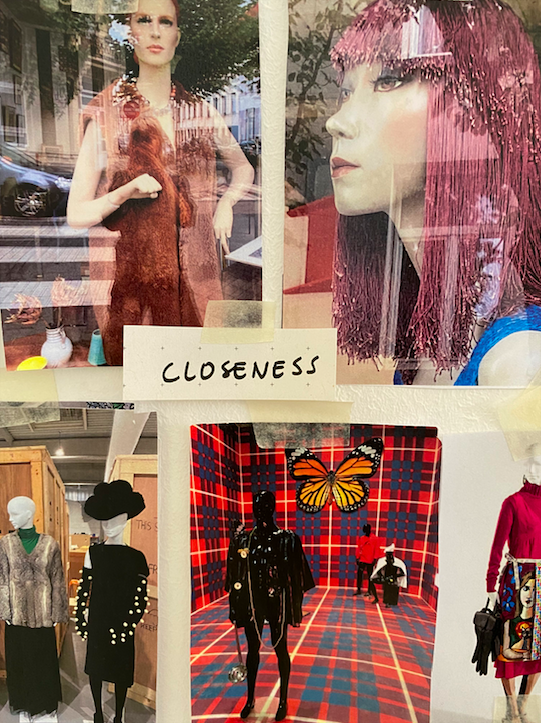
Can you think of any links that have presented themselves between yours and another project members’ work during this process?
When you make fashion exhibitions, you are trying to find innovative ways to bring the garments to life. Fashion is meant to be worn, garments are part of daily life and rituals. Movement, however, is often missing in the stillness of a museum display. When Richard Haines came to MoMu last year, I was amazed to see how he transformed our dressed mannequins into real women. His illustrations introduced movement into their uncanny stillness in a way that felt very energizing to me.
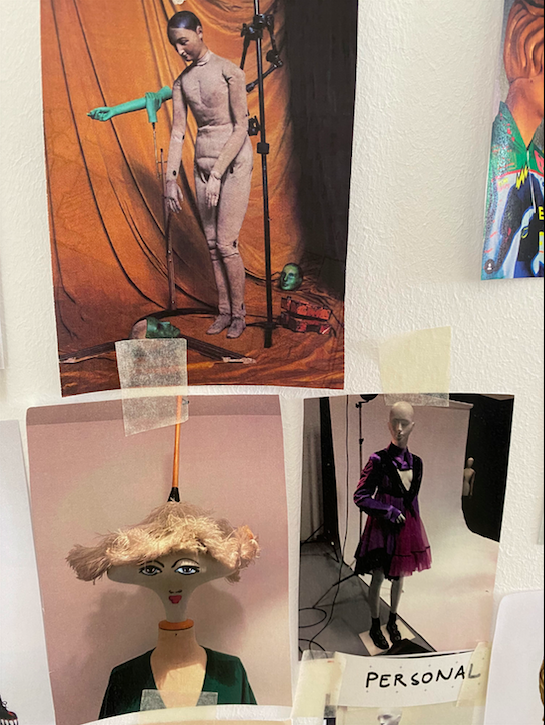
Olga Vainshtein
Project member / Senior Researcher, Russian State University for the Humanities in Moscow
What is your favourite fashion medium?
My favourite fashion medium are literature and book illustrations. My background is the history of English literature and I enjoy reading novels and making notes. The connection between the written word, the mental image forming in the reader’s mind, and the book illustrations fascinates me. Fashion is one of the links in this moveable web, that can further embrace painting and photography.
What one image/story/example best articulates your tie to your chosen fashion medium?
When I first read the treatise by Barbey D’Aurevilly “On Dandyism and George Brummell” I was struck by his description of dandies scraping their clothes with a sharp glass:
“The dandies dreamed up a style that might be called the threadbare look… this was the dandyish idea of having their clothes distressed before they put them on, rubbed all over till they were no more than a kind of lace – a mist of cloth. They were gods who wanted to walk in their clouds! To do it they used a piece of sharpened glass, and the procedure was extremely delicate and time-consuming. Now that was a true act of dandyism. The clothes themselves are nothing to do with it, since by that point they scarcely existed!
(Barbey D’Aurevilly. On Dandyism and George Brummell. 2002, transl. George Walden, Gibson Square Books, p. 80)
I was impressed and vividly imagined this procedure. I have already thought about different ways of deconstructing clothes like ragged and stone-washed jeans or how Hussein Chalayan buried clothes for them to look rotten and then dug them up… But unfortunately, as I understood later, reliable evidences for this method are non-existent. This is a product of the subtle imagination of Barbey D’Aurevilly. It is his artistic style and the power of words that created this unbelievable illusion of truth.

What have you learned from focusing on medium?
The first thing you should do is analyze the medium and understand how it works. It is never transparent. Representation of clothes in fiction is most vivid in dramatic situations. But garments worn in ordinary life often escape description. They remain sort of invisible. Also, literary texts possess their own logic and structure, and we should always remember the genre conventions. For instance, in this fragment from The Duino Elegies by Rainer Maria Rilke we are facing not a realistic description of a Parisian milliner, but a mystical allegory of Death at work:
the milliner, Madame Lamort,
winds and twists the restless trails of the earth,
endless ribbons, into new
bows, frills, flowers, rosettes, artificial fruits – all
falsely coloured, – for winter’s
cheap hats of destiny.
(Translated by A. S. Kline)
What is your favourite example from your research that shows medium impacting fashion’s meanings?
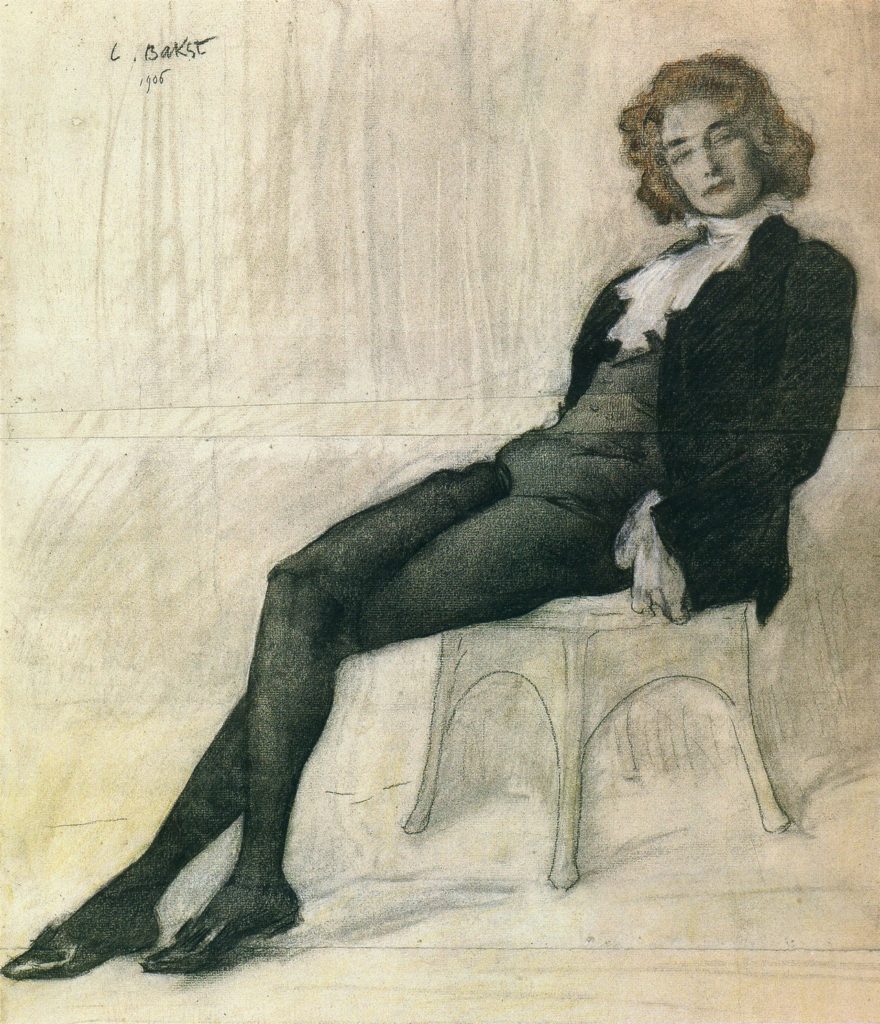
This is a portrait of the famous Russian poet Zinaida Gippius by Leon Bakst (1906). Sitting for this portrait she donned Little lord Fauntleroy suit – knee-length pants, stockings, a black velvet jacket, and shirt with frilled front – and obviously, she felt quite comfortable in it. Posing in boys’ attire for a woman was at that time a flamboyant and rebellious act, yet it allowed Gippius to achieve the desired effect of detachment and aristocratism. Choosing Fauntleroy look, Gippius successfully transgresses conventional boundaries of gender, historical period, age and social status. Thus she managed to make the Fauntleroy suit an instrument of woman’s empowerment, creating her own rules of the game.
Can you think of any links that have presented themselves between yours and another project members’ work during this process?
I am always interested in what Rebecca Arnold does, and I am a big fan of her (together with Beatrice Behlen) podcast Bande à Part. Leanne Shapton is one of the editors of the anthology I use a lot – Women in Clothes. I share Judith Clark’s interest in children’s literature and its impact on fashion. And I have recently used the article of Elizabeth Kutesko Problems and Tensions in the Representation of the Sapeurs for my research on sartorial codes of sapeurs.
To learn more about our upcoming symposium, please visit: https://courtauld.ac.uk/research/research-forum/events/fashioninterpretations

